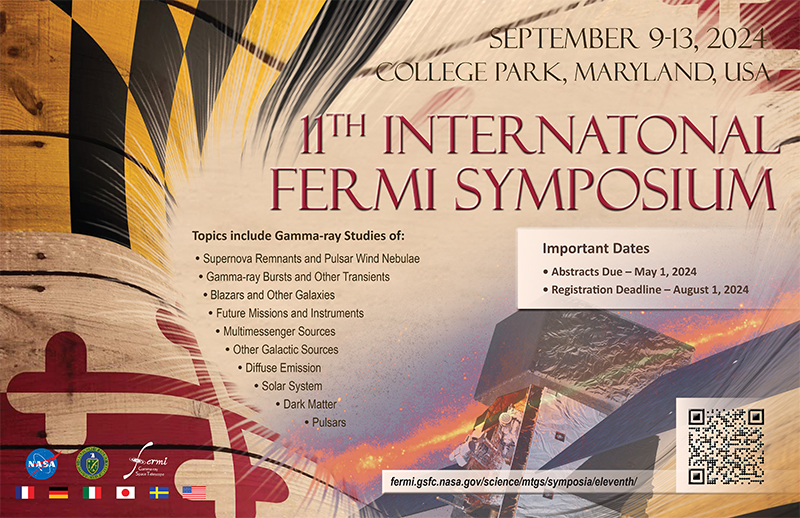11th International Fermi Symposium
Date:
September 9-13, 2024
Location:
Samuel Riggs IV Alumni Center
7801 Alumni Drive College Park, MD 20742
Get Directions
Important Dates
- Contributed talk abstract submission closed.
Posters will continue to be accepted until August 1, 2024 - August 1, 2024 - Regular Registration Deadline
- August 7, 2024 - Final Registration Deadline - no later registrations will be accepted
- September 5, 2024 - Virtual Attendance Registration Deadline
Overview
This symposium follows previous Fermi Symposia at Stanford, CA (February 2007), Washington, DC (November 2009), Rome, Italy (May 2011), Monterey, CA (November 2012), Nagoya, Japan (October 2014), Arlington, VA (November 2015), Garmisch-Partenkirchen, Germany (October 2017), Baltimore, MD (October 2018), virtual (April 2021), and Johannesburg, South Africa (October 2022).
The two Fermi instruments have been surveying the high-energy sky since August 2008. The Large Area Telescope (LAT) has discovered more than seven thousand new sources and many new source classes, bringing the importance of gamma-ray astrophysics to an ever-broadening community. The LAT catalog includes supernova remnants, pulsar wind nebulae, pulsars, binary systems, novae, several classes of active galaxies, starburst galaxies, normal galaxies, and a large number of unidentified sources. Continuous monitoring of the high-energy gamma-ray sky has uncovered numerous outbursts from a wide range of transients. Fermi LAT's study of diffuse gamma-ray emission in our galaxy revealed giant bubbles shining in gamma rays. The direct measurement of a harder-than-expected cosmic-ray electron spectrum may imply the presence of nearby cosmic-ray accelerators. LAT data have provided stringent constraints on new phenomena such as supersymmetric dark-matter annihilations as well as tests of fundamental physics. The Gamma-ray Burst Monitor (GBM) continues to be a prolific detector of gamma-ray transients: magnetars, solar flares, terrestrial gamma-ray flashes and gamma-ray bursts at keV to MeV energies, and complementing gravitational wave observations by LIGO/Virgo/KAGRA and the higher energy LAT observations of those sources.
All gamma-ray data are made immediately available at the Fermi Science Support Center. These publicly available data and Fermi analysis tools have enabled a large number of important studies. We especially encourage guest investigators worldwide to participate in this symposium to share results and to learn about upcoming opportunities.
This meeting will focus on the new scientific investigations and results enabled by Fermi, the mission and instrument characteristics, future opportunities, and coordinated observations and analyses.
Invited Speakers
- Alessandro Bruno
- Niccolo Bucciantini
- Songzhan Chen
- Milena Crnogorcevic
- Adi Foord
- Michelle Hui
- Sasha Kashlinsky
- Bruno Khélifi
- Ioannis Liodakis
- Alexander Philippov
- Samuele Ronchini
- Benjamin R. Safdi
- Tinn Thongmeearkom
- Kartick Sarkar
Organizing Committees
Scientific Organizing Committee
- Liz Hays (co-chair)
- Judy Racusin (co-chair)
- Peter Shawhan (co-chair)
- Justin Finke (co-chair)
- Miguel Araya
- Zhen Cao
- Benoît Cerutti
- Paolo Coppi
- Alessandra Corsi
- Fiorenza Donato
- Ke Fang
- Deirdre Horan
- Brian Humensky
- Yoshiyuki Inoue
- Paul Lasky
- Alicia López-Oramas
- Peter Michelson
- Lara Nava
- Michela Negro
- Naoko Neilson
- Melissa Pesce-Rollins
- Maria Petropoulou
- Felix Ryde
- Miguel Sánchez-Conde
- David Smith
- Andreas von Kienlin
- Colleen Wilson-Hodge
Local Organizing Committee
- Lynn Cominsky
- Abhishek Desai
- Chris Karwin
- Aaliyah Kerr
- Judy Racusin
- Giovanna Senatore
- Vidushi Sharma
- George Younes
- Haocheng Zhang
Contact
Questions? Email the organizers at: fermi-symposium@lists.nasa.gov





